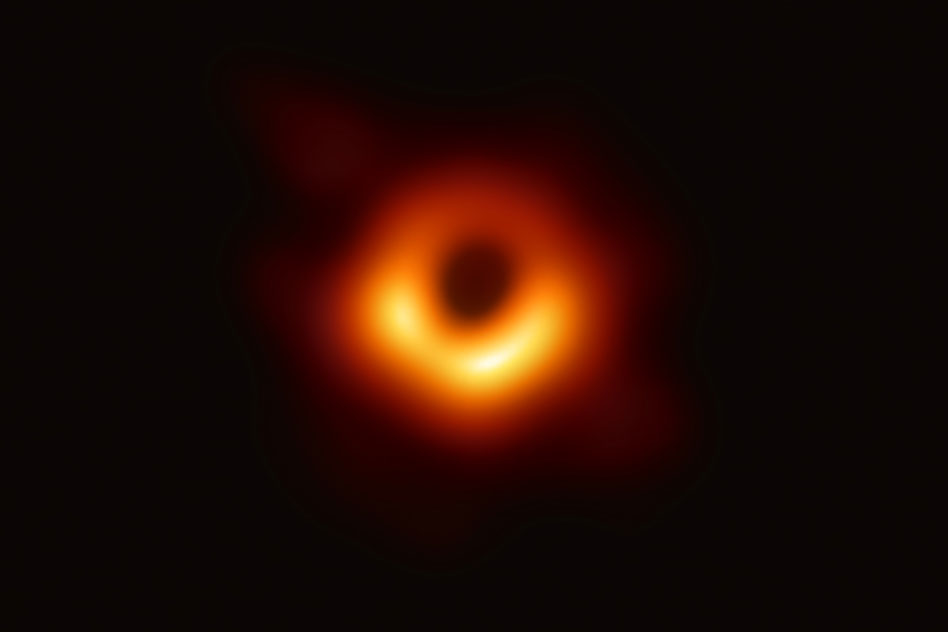1st black hole imaged by humanity is confirmed to be spinning, study finds
The historic 'donut' black hole M87* is, in fact, spinning.

The supermassive black hole M87*, which rose to fame in 2019 when it became the first void to be imaged and revealed a fuzzy orange donut (then later sharpened by AI into a skinny ring), is now confirmed to be spinning. The announcement of this update came on Wednesday (Sept. 27). However, as to how fast M87* is spinning? That's not yet known.
For two decades, a network of radio telescopes have been eyeing the black hole, which resides in the heart of the Messier 87 (M87) galaxy about 55 million light-years away from Earth in the constellation Virgo. These instruments have been especially intrigued by a powerful jet of radiation and particles blasting from the black hole's poles, and according to new results, that relativistic jet appears to be swinging like a pendulum on a 11-year cycle. Scientists say this is because of gravitational interactions between the spinning black hole, which is thought to be some 6.5 billion times more massive than the sun, and the disk of material around it, providing "unequivocal evidence" for the black hole's spin.
"We are thrilled by this significant finding," Cui Yuzhu, who is a researcher at Zhejiang Lab in China and the lead author of the new study, said in a statement. To sniff out the 11-year swing period of the jet, Yuzhu explains the team had to accumulate high-resolution data tracing M87's structure over two decades and conduct a thorough analysis to obtain the key information.
Related: Astronomers snap 1st-ever direct image of a black hole blasting out a powerful jet
The jet changes its directions by roughly 10 degrees once every 11 years, according to the new study. The results are also consistent with theoretical supercomputer simulations and will help shed light on how black holes form and evolve into the monstrous beasts we see them as all across the universe, scientists say.
In 2019, astronomers had spotted wobbling jets escaping from a black hole much closer to us, about 8,000 light-years from Earth. Those jets swung over time periods of just a few minutes, which, to date, marks the most rapid oscillations of this kind observed by astronomers.
Comparatively, the latest findings show M87's black hole jets follow a much longer timeframe. However, they are still consistent with theoretical predictions made by Einstein in his landmark theory of general relativity.
Breaking space news, the latest updates on rocket launches, skywatching events and more!
According to this theory, the spinning black hole is so massive that it pulls the surrounding fabric of space and time inward in what's called frame-dragging. Specifically, the effect comes to light with the team's new study because the spin axis of a black hole is not perfectly aligned with the rotation axis of the surrounding accretion disk from which the black hole sucks stellar material. This triggers the black hole's jets to wobble ever so slightly, which was what was measured in the new study.
The specific processes that cause black holes to spin are not very well understood. A leading theory suggests smaller black holes form by feeding on star matter through an accretion disk, which causes them to spin rapidly. Over eons, they are thought to collide and eventually merge to form supermassive black holes.
These second generation black holes are expected to spin slower compared to their younger counterparts. To really confirm the hypothesis, researchers need to study spin rates of black holes sporting different sizes, and the latest study could be a step in that direction.
This research was described in a paper published Wednesday (Sept. 27) in the journal Nature.

Sharmila Kuthunur is an independent space journalist based in Bengaluru, India. Her work has also appeared in Scientific American, Science, Astronomy and Live Science, among other publications. She holds a master's degree in journalism from Northeastern University in Boston.
